2013 FORD SUPER DUTY overheating
[x] Cancel search: overheatingPage 16 of 95

FUEL REQUIREMENTS - CHOOSING THE RIGHT FUEL: VEHICLES
OPERATED WHERE ULTRA LOW SULFUR DIESEL FUEL IS NOT
REQUIRED
For the engine to operate reliably on low-sulfur or high-sulfur diesel fuel,
the engine must be a factory built high-sulfur engine (available as a
dealer order option for select markets) or a ULSD (ultra low sulfur
diesel) fuel configured engine that has been retrofitted for high-sulfur
diesel fuel using Ford Motor Company dealer service parts. Failure to use
retrofit components other than those available through your authorized
dealer will result in engine coolant system damage, engine overheating,
SCR and/or DPF damage and possible base engine damage.
Use only a diesel engine that has been configured for use with high
sulfur diesel fuel in markets with diesel fuel that has sulfur content
greater than 15 ppm. Using low sulfur diesel fuel (16–500 ppm) or
high sulfur diesel fuel (greater than 500 ppm) in a diesel engine
designed to use only Ultra Low Sulfur Diesel fuel may result in
damage to engine emission control devices and the aftertreatment
system, potentially rendering the vehicle inoperable.
Vehicles with engines configured for use with high sulfur diesel fuel will
only be made available for sale in countries where ULSD fuel is generally
not available or mandated by the government. Vehicles originally sold in
a ULSD fuel market that are subsequently exported to non-ULSD fuel
markets will need to be retrofitted (at the customer’s expense using Ford
authorized dealer service parts) in order to be reliably operated on
non-ULSD fuel.
BIODIESEL
WARNING:Do not use home heating oil, agricultural fuel, raw
fats and oils, waste cooking greases, biodiesel fuels greater than
20% or any diesel fuel not intended for highway use. Damage to the
fuel injection system, engine and exhaust catalyst can occur if an
improper fuel is used. Do not add gasoline, gasohol or alcohol to diesel
fuel. This practice creates a serious fire hazard and engine
performance problems.
This vehicle may be operated on diesel fuels containing up to 20%
biodiesel, also known as B20.
Biodiesel fuel is a product that has been chemically converted from
renewable fuel sources, such as vegetable oils, animal fats and waste
cooking greases.
Fuel and Refueling
15
2013 Diesel(67l)
Supplement, 1st Printing
USA(fus)
Page 54 of 95
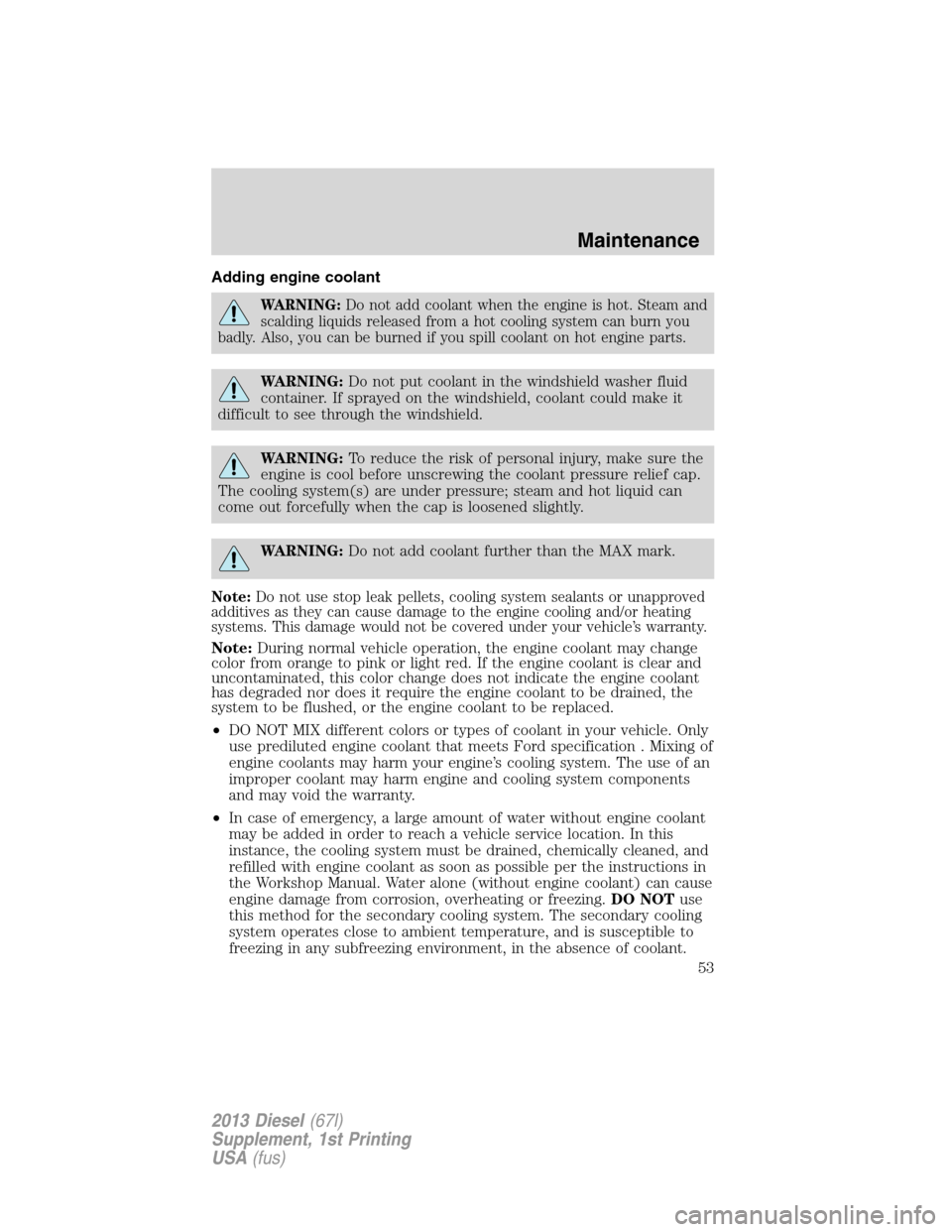
Adding engine coolant
WARNING:Do not add coolant when the engine is hot. Steam and
scalding liquids released from a hot cooling system can burn you
badly. Also, you can be burned if you spill coolant on hot engine parts.
WARNING:Do not put coolant in the windshield washer fluid
container. If sprayed on the windshield, coolant could make it
difficult to see through the windshield.
WARNING:To reduce the risk of personal injury, make sure the
engine is cool before unscrewing the coolant pressure relief cap.
The cooling system(s) are under pressure; steam and hot liquid can
come out forcefully when the cap is loosened slightly.
WARNING:Do not add coolant further than the MAX mark.
Note:Do not use stop leak pellets, cooling system sealants or unapproved
additives as they can cause damage to the engine cooling and/or heating
systems. This damage would not be covered under your vehicle’s warranty.
Note:During normal vehicle operation, the engine coolant may change
color from orange to pink or light red. If the engine coolant is clear and
uncontaminated, this color change does not indicate the engine coolant
has degraded nor does it require the engine coolant to be drained, the
system to be flushed, or the engine coolant to be replaced.
•DO NOT MIX different colors or types of coolant in your vehicle. Only
use prediluted engine coolant that meets Ford specification . Mixing of
engine coolants may harm your engine’s cooling system. The use of an
improper coolant may harm engine and cooling system components
and may void the warranty.
•In case of emergency, a large amount of water without engine coolant
may be added in order to reach a vehicle service location. In this
instance, the cooling system must be drained, chemically cleaned, and
refilled with engine coolant as soon as possible per the instructions in
the Workshop Manual. Water alone (without engine coolant) can cause
engine damage from corrosion, overheating or freezing.DO NOTuse
this method for the secondary cooling system. The secondary cooling
system operates close to ambient temperature, and is susceptible to
freezing in any subfreezing environment, in the absence of coolant.
Maintenance
53
2013 Diesel(67l)
Supplement, 1st Printing
USA(fus)
Page 55 of 95
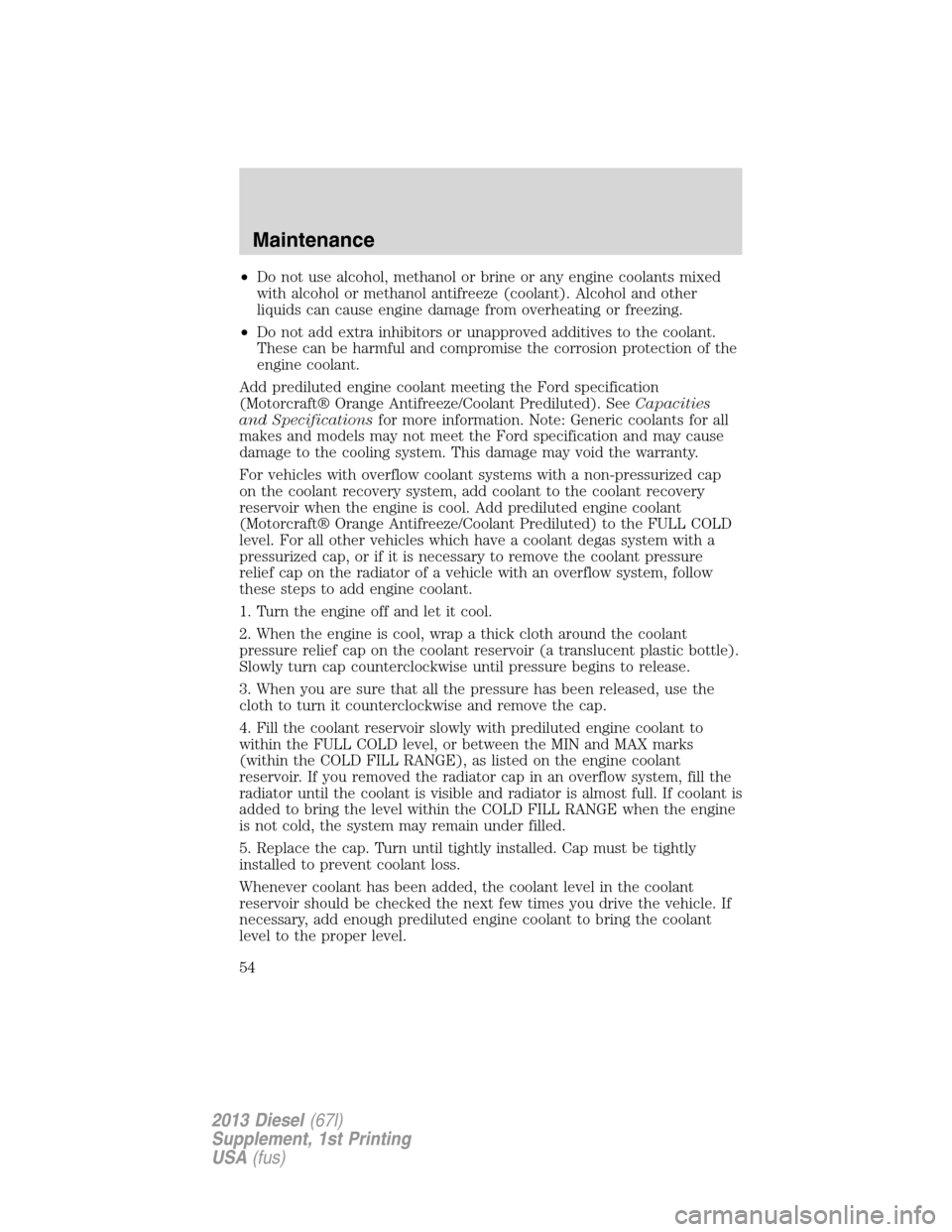
•Do not use alcohol, methanol or brine or any engine coolants mixed
with alcohol or methanol antifreeze (coolant). Alcohol and other
liquids can cause engine damage from overheating or freezing.
•Do not add extra inhibitors or unapproved additives to the coolant.
These can be harmful and compromise the corrosion protection of the
engine coolant.
Add prediluted engine coolant meeting the Ford specification
(Motorcraft® Orange Antifreeze/Coolant Prediluted). SeeCapacities
and Specificationsfor more information. Note: Generic coolants for all
makes and models may not meet the Ford specification and may cause
damage to the cooling system. This damage may void the warranty.
For vehicles with overflow coolant systems with a non-pressurized cap
on the coolant recovery system, add coolant to the coolant recovery
reservoir when the engine is cool. Add prediluted engine coolant
(Motorcraft® Orange Antifreeze/Coolant Prediluted) to the FULL COLD
level. For all other vehicles which have a coolant degas system with a
pressurized cap, or if it is necessary to remove the coolant pressure
relief cap on the radiator of a vehicle with an overflow system, follow
these steps to add engine coolant.
1. Turn the engine off and let it cool.
2. When the engine is cool, wrap a thick cloth around the coolant
pressure relief cap on the coolant reservoir (a translucent plastic bottle).
Slowly turn cap counterclockwise until pressure begins to release.
3. When you are sure that all the pressure has been released, use the
cloth to turn it counterclockwise and remove the cap.
4. Fill the coolant reservoir slowly with prediluted engine coolant to
within the FULL COLD level, or between the MIN and MAX marks
(within the COLD FILL RANGE), as listed on the engine coolant
reservoir. If you removed the radiator cap in an overflow system, fill the
radiator until the coolant is visible and radiator is almost full. If coolant is
added to bring the level within the COLD FILL RANGE when the engine
is not cold, the system may remain under filled.
5. Replace the cap. Turn until tightly installed. Cap must be tightly
installed to prevent coolant loss.
Whenever coolant has been added, the coolant level in the coolant
reservoir should be checked the next few times you drive the vehicle. If
necessary, add enough prediluted engine coolant to bring the coolant
level to the proper level.
Maintenance
54
2013 Diesel(67l)
Supplement, 1st Printing
USA(fus)
Page 56 of 95

If you have to add more than 1.0 quart (1.0 liter) of engine coolant per
month, have your authorized dealer check the engine cooling system.
Your cooling system may have a leak. Operating an engine with a low level
of coolant can result in engine overheating and possible engine damage.
Engine and secondary cooling system refill procedure
The following procedure should be used when refilling the engine or
secondary cooling systems after it has been drained or become extremely
low.
1. Before you remove the cap, turn the engine off and let it cool.
2. When the engine is cool, wrap a thick cloth around the cap. Slowly
turn cap counterclockwise until pressure begins to release.
3. Step back while the pressure releases.
4. When you are sure that all the pressure has been released, use the
cloth to turn it counterclockwise and remove the cap.
5. Slowly add prediluted engine coolant to the coolant reservoir until the
coolant level is within the COLD FILL RANGE as listed on the reservoir.
6. Reinstall the pressure relief cap.
7. Start and run the engine at 2,000 rpm for 2 minutes.
8. Shut engine off, and remove the pressure relief cap as previously
outlined.
9. If required, add prediluted engine coolant to the coolant reservoir until
the coolant level is within the COLD FILL RANGE as listed on the
reservoir.
10. Engine cooling system: Repeat Step 5 until the coolant level has
stabilized (is no longer dropping after each step) AND the upper radiator
hose at the radiator is warm to the touch (indicating that the engine
thermostat is open and coolant is flowing through the radiator).
Secondary cooling system: Repeat Step 5 until the coolant level has
stabilized (is no longer dropping after each step) AND the lower
passenger side of the secondary radiator is warm to the touch
(indicating secondary thermostat is open and coolant is flowing
through the entire system).
11. Reinstall the pressure relief cap. Shut the engine off and let it cool.
12. Check the coolant level in the reservoir before you drive your vehicle
the next few times (with the engine cool).
Maintenance
55
2013 Diesel(67l)
Supplement, 1st Printing
USA(fus)
Page 73 of 95
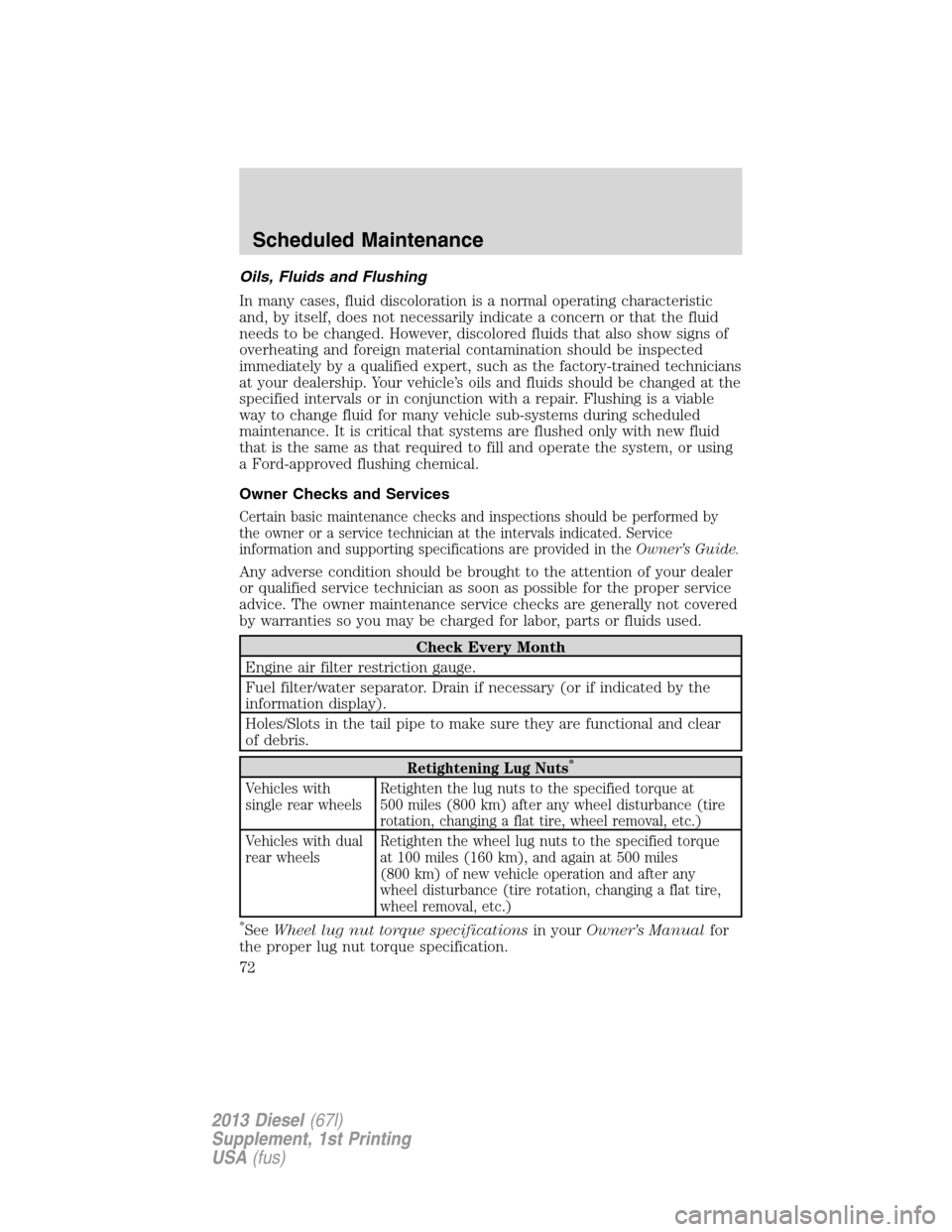
Oils, Fluids and Flushing
In many cases, fluid discoloration is a normal operating characteristic
and, by itself, does not necessarily indicate a concern or that the fluid
needs to be changed. However, discolored fluids that also show signs of
overheating and foreign material contamination should be inspected
immediately by a qualified expert, such as the factory-trained technicians
at your dealership. Your vehicle’s oils and fluids should be changed at the
specified intervals or in conjunction with a repair. Flushing is a viable
way to change fluid for many vehicle sub-systems during scheduled
maintenance. It is critical that systems are flushed only with new fluid
that is the same as that required to fill and operate the system, or using
a Ford-approved flushing chemical.
Owner Checks and Services
Certain basic maintenance checks and inspections should be performed by
the owner or a service technician at the intervals indicated. Service
information and supporting specifications are provided in theOwner’s Guide.
Any adverse condition should be brought to the attention of your dealer
or qualified service technician as soon as possible for the proper service
advice. The owner maintenance service checks are generally not covered
by warranties so you may be charged for labor, parts or fluids used.
Check Every Month
Engine air filter restriction gauge.
Fuel filter/water separator. Drain if necessary (or if indicated by the
information display).
Holes/Slots in the tail pipe to make sure they are functional and clear
of debris.
Retightening Lug Nuts*
Vehicles with
single rear wheelsRetighten the lug nuts to the specified torque at
500 miles (800 km) after any wheel disturbance (tire
rotation, changing a flat tire, wheel removal, etc.)
Vehicles with dual
rear wheelsRetighten the wheel lug nuts to the specified torque
at 100 miles (160 km), and again at 500 miles
(800 km) of new vehicle operation and after any
wheel disturbance (tire rotation, changing a flat tire,
wheel removal, etc.)
*SeeWheel lug nut torque specificationsin yourOwner’s Manualfor
the proper lug nut torque specification.
Scheduled Maintenance
72
2013 Diesel(67l)
Supplement, 1st Printing
USA(fus)
Page 83 of 95
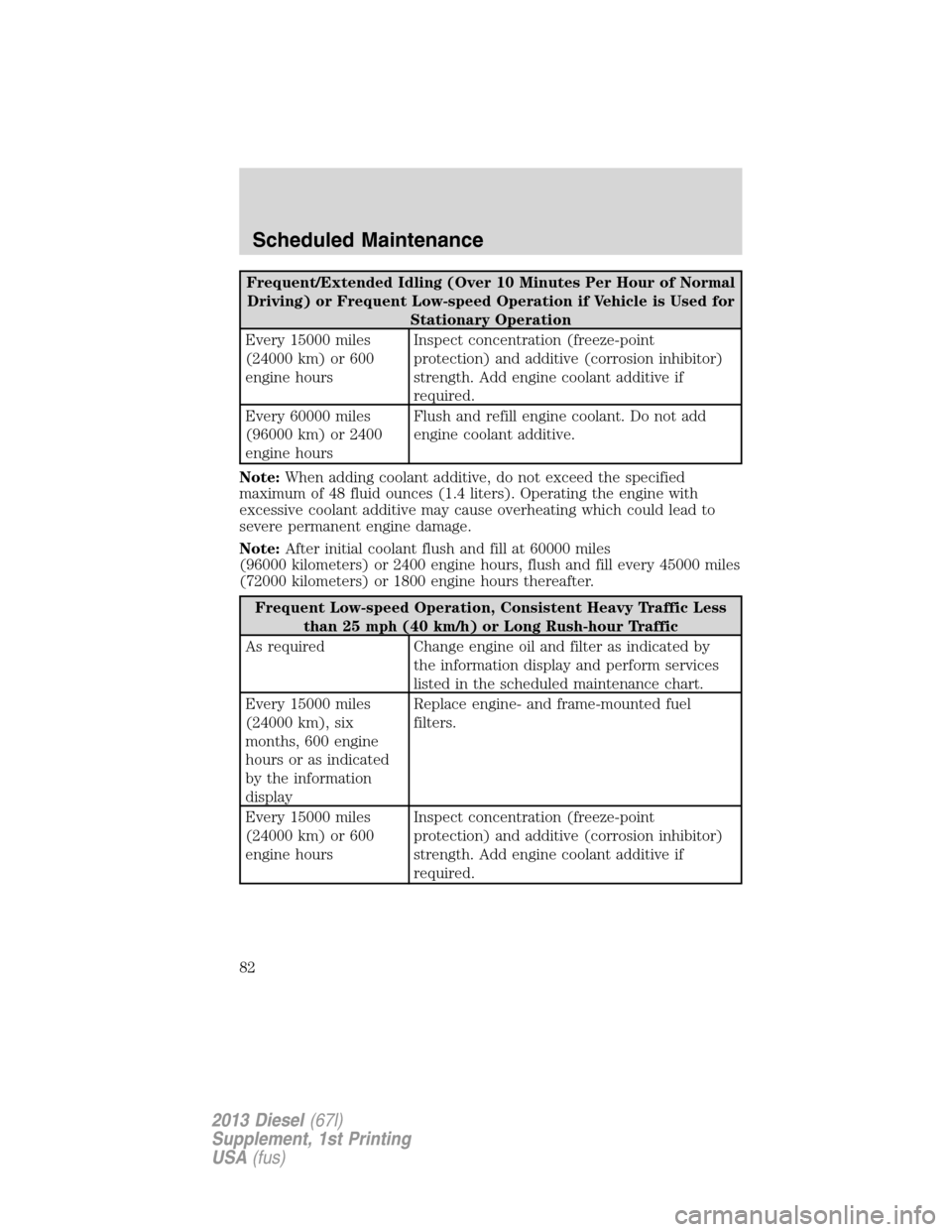
Frequent/Extended Idling (Over 10 Minutes Per Hour of Normal
Driving) or Frequent Low-speed Operation if Vehicle is Used for
Stationary Operation
Every 15000 miles
(24000 km) or 600
engine hoursInspect concentration (freeze-point
protection) and additive (corrosion inhibitor)
strength. Add engine coolant additive if
required.
Every 60000 miles
(96000 km) or 2400
engine hoursFlush and refill engine coolant. Do not add
engine coolant additive.
Note:When adding coolant additive, do not exceed the specified
maximum of 48 fluid ounces (1.4 liters). Operating the engine with
excessive coolant additive may cause overheating which could lead to
severe permanent engine damage.
Note:After initial coolant flush and fill at 60000 miles
(96000 kilometers) or 2400 engine hours, flush and fill every 45000 miles
(72000 kilometers) or 1800 engine hours thereafter.
Frequent Low-speed Operation, Consistent Heavy Traffic Less
than 25 mph (40 km/h) or Long Rush-hour Traffic
As required Change engine oil and filter as indicated by
the information display and perform services
listed in the scheduled maintenance chart.
Every 15000 miles
(24000 km), six
months, 600 engine
hours or as indicated
by the information
displayReplace engine- and frame-mounted fuel
filters.
Every 15000 miles
(24000 km) or 600
engine hoursInspect concentration (freeze-point
protection) and additive (corrosion inhibitor)
strength. Add engine coolant additive if
required.
Scheduled Maintenance
82
2013 Diesel(67l)
Supplement, 1st Printing
USA(fus)
Page 84 of 95
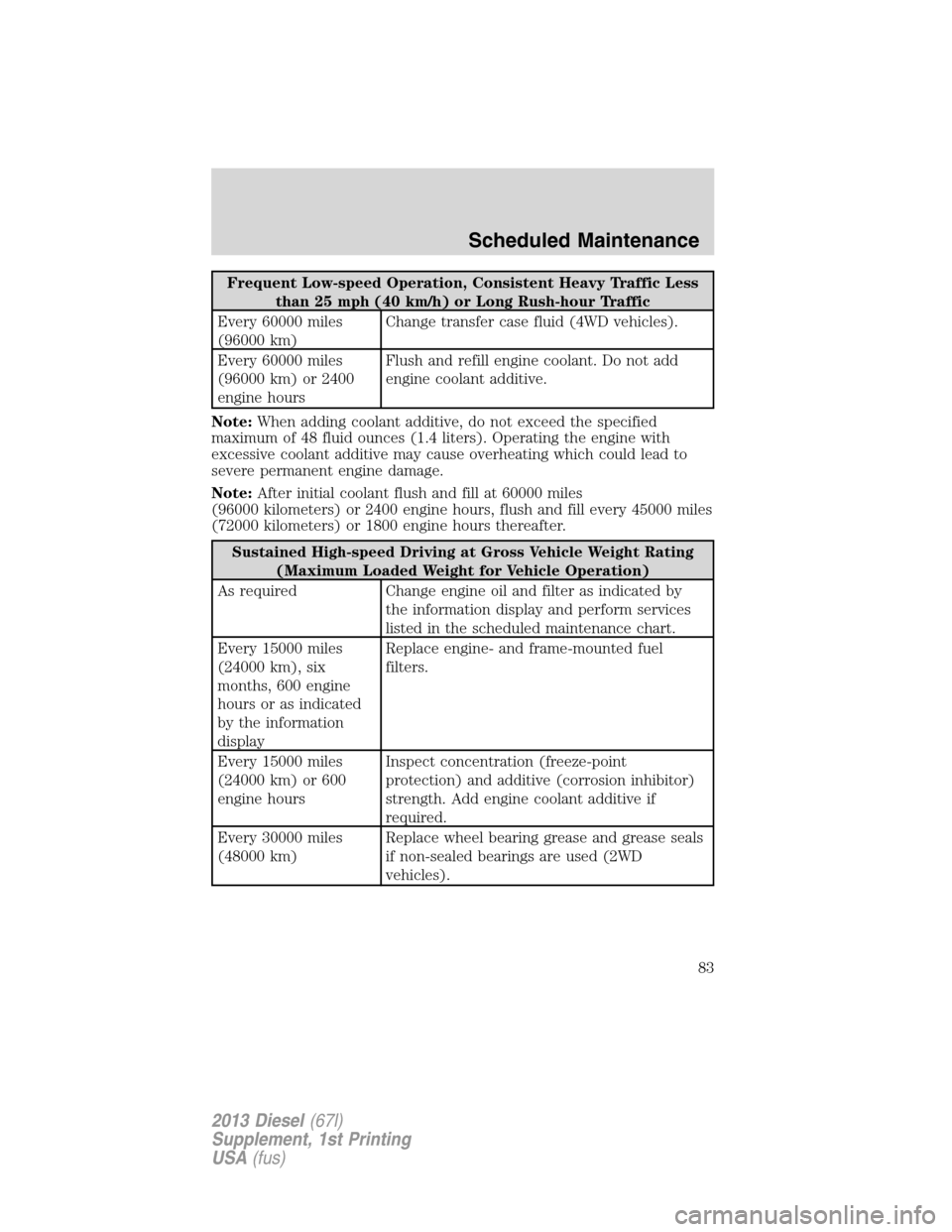
Frequent Low-speed Operation, Consistent Heavy Traffic Less
than 25 mph (40 km/h) or Long Rush-hour Traffic
Every 60000 miles
(96000 km)Change transfer case fluid (4WD vehicles).
Every 60000 miles
(96000 km) or 2400
engine hoursFlush and refill engine coolant. Do not add
engine coolant additive.
Note:When adding coolant additive, do not exceed the specified
maximum of 48 fluid ounces (1.4 liters). Operating the engine with
excessive coolant additive may cause overheating which could lead to
severe permanent engine damage.
Note:After initial coolant flush and fill at 60000 miles
(96000 kilometers) or 2400 engine hours, flush and fill every 45000 miles
(72000 kilometers) or 1800 engine hours thereafter.
Sustained High-speed Driving at Gross Vehicle Weight Rating
(Maximum Loaded Weight for Vehicle Operation)
As required Change engine oil and filter as indicated by
the information display and perform services
listed in the scheduled maintenance chart.
Every 15000 miles
(24000 km), six
months, 600 engine
hours or as indicated
by the information
displayReplace engine- and frame-mounted fuel
filters.
Every 15000 miles
(24000 km) or 600
engine hoursInspect concentration (freeze-point
protection) and additive (corrosion inhibitor)
strength. Add engine coolant additive if
required.
Every 30000 miles
(48000 km)Replace wheel bearing grease and grease seals
if non-sealed bearings are used (2WD
vehicles).
Scheduled Maintenance
83
2013 Diesel(67l)
Supplement, 1st Printing
USA(fus)
Page 85 of 95

Sustained High-speed Driving at Gross Vehicle Weight Rating
(Maximum Loaded Weight for Vehicle Operation)
Every 50000 miles
(80000 km)Change rear axle fluid (if equipped with a
Dana rear axle - some F-350s, all F-450/550s).
Change transfer case fluid (4WD vehicles).
Every 60000 miles
(96000 km) or 2400
engine hoursFlush and refill engine coolant. Do not add
engine coolant additive.
Note:When adding coolant additive, do not exceed the specified
maximum of 48 fluid ounces (1.4 liters). Operating the engine with
excessive coolant additive may cause overheating which could lead to
severe permanent engine damage.
Note:After initial coolant flush and fill at 60000 miles
(96000 kilometers) or 2400 engine hours, flush and fill every 45000 miles
(72000 kilometers) or 1800 engine hours thereafter.
Operating in Sustained Ambient Temperatures Below -10°F
(-23°C) or Above 100°F (38°C)
As required Change engine oil and filter as indicated by
the information display and perform services
listed in the scheduled maintenance chart.
Every 15000 miles
(24000 km), six
months, 600 engine
hours or as indicated
by the information
displayReplace engine- and frame-mounted fuel
filters.
Every 30000 miles
(48000 km)Replace wheel bearing grease and grease seals
if non-sealed bearings are used (2WD
vehicles).
Every 60000 miles
(96000 km)Change transfer case fluid (4WD vehicles).
Scheduled Maintenance
84
2013 Diesel(67l)
Supplement, 1st Printing
USA(fus)